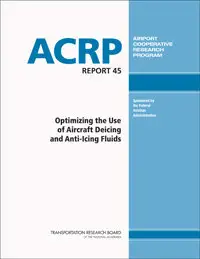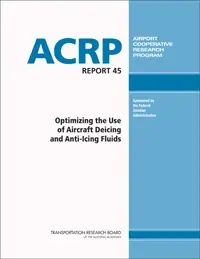"Optimizing the Use of Aircraft Deicing and Anti-Icing Fluids" by John D’Avirro, Michael Chaput
Airport Cooperative Research Program (ACRP) Report 45; National Research Council; Transportation Research Board; Federal Aviation Administration; National Academy of Sciences
TRB, NA Press | 2011 | ISBN: 9780309155519 | 104 pages | PDF | 4 MB
Airport Cooperative Research Program (ACRP) Report 45; National Research Council; Transportation Research Board; Federal Aviation Administration; National Academy of Sciences
TRB, NA Press | 2011 | ISBN: 9780309155519 | 104 pages | PDF | 4 MB
The Report includes a series of best management practices that have the potential to be immediately implemented, and highlights the detailed findings and recommendations of experiments to evaluate holdover time determination systems, spot deicing for aircraft frost removal, and ADAF dilutions. Report 45 provides guidance on procedures and technologies designed to help reduce the use of aircraft deicing and anti-icing fluids (ADAF) while maintaining safe aircraft operations across the wide range of winter weather conditions found in the United States and Canada.
Current understanding of the mechanisms of the formation, retention and removal of ice from, and its detection on, critical aircraft surfaces is incomplete, leading to conservative deicing and anti-icing practices that may waste some portion of the aircraft deicing and anti-icing fluids (ADAF) used for this critical function. Airports are under regulatory pressure to minimize the quantity of spent ADAF discharged to waterways or sewage treatment plants because the fluids can contribute to aquatic toxicity, excessive chemical and biological oxygen demand, and deterioration of the airport infrastructure. Sums in excess of $10 million have been spent at individual airports to mitigate ADAF stormwater runoff.
The objective of this research was to identify procedures and technologies that optimize the use of aircraft deicing and anti-icing fluids, thus reducing their environmental impact while assuring safe aircraft operations in deicing and anti-icing conditions. The project produced (1) a description of the application of currently available procedures and technologies to optimize ADAF use, (2) the results of an experiment to validate the effectiveness of promising procedures and technologies, (3) a plan for implementation of these promising procedures and technologies, and (4) recommendations for further study.
CONTENTS
1 Chapter 1 Project Summary
1 Phase I: Promising De/Anti-Icing Source Reduction Practices
1 Phase II: Research and Development on Four Selected Topics
1 Fact Sheets for De/Anti-Icing Optimization
1 Holdover Time Variance Across an Airfield
2 Increased Use of Spot Deicing for Aircraft Frost Removal
2 Increased Use of Aircraft De/Anti-Icing Fluid Dilutions
3 Chapter 2 Promising De/Anti-Icing Source Reduction Practices
3 Introduction
3 Objective
3 Organization
4 Research Approach
4 Literature Review and Data Examination
5 Focus Group
5 Survey
6 Findings and Applications
6 Aircraft De/Anti-Icing Optimization Technologies and Procedures
6 Preliminary List of De/Anti-Icing Optimization Technologies and Procedures
7 Elimination of Items with Low Potential for Success
7 Development of Final List of Technologies and Procedures
9 Focus Group Survey Inputs on Final List of Technologies and Procedures
17 Overall Ranking of Optimization Technologies and Procedures
22 Conclusions and Recommendations
22 Conclusions
22 Recommendations for Further Study
23 Recommendations for Phase II
24 Bibliography
28 Chapter 3 Holdover Time Variance Across an Airfield
28 Introduction
28 Preliminary Testing (Winter 2007–08)
28 Additional Testing (Winter 2008–09)
29 Research Approach and Methodologies
29 Test Procedures for Data Collection
29 Focus Airports
29 Test Locations and Remote Test Unit
29 Equipment and Methodology for Precipitation Measurement
30 Sequence of Events
32 Personnel
32 Data Forms
32 Description of Data and Methodology Used to Process
32 Tests Conducted
38 Summary of Test Events
38 Test Data Log
38 Scatter Diagram of Logged Data
41 Data Analysis
44 Findings and Applications
44 Between-Site Differences in HOT
47 Examination of Site Separation Distance
49 Examination of Lake-Effect Snowfall on HOT Differences
51 Comparison of HOTDS Results to Current Operational Practices
52 HOTDS Implementation Strategy and Timeline
53 Conclusions and Recommendations
53 Conclusions
54 Recommendations
55 References
56 Chapter 4 Increased Use of Spot Deicing for Aircraft Frost Removal
56 Introduction
56 Deicing for Frost Removal
56 Spot Deicing for Frost Removal
56 Objective
57 Research Approach and Methodologies
57 Examination of Current Government and Industry Regulations, Guidance Materials, and Standards
57 Laboratory Tests
61 Focus Group Survey
63 Cost-Benefit Model
63 Step 1: Examination of Potential Cost-Benefit Model Parameters
64 Step 2: Cost-Benefit Model Development and Testing
65 Findings and Applications
65 Examination of Current Government and Industry Regulations, Guidance Material, and Standards
66 Laboratory Tests
68 Focus Group Survey
69 Cost-Benefit Model
70 Conclusions, Recommendations, and Suggested Research
70 Conclusions
72 Recommendations
73 Suggested Research
74 Chapter 5 Increased Use of Aircraft De/Anti-Icing Fluid Dilutions
74 Introduction
74 Background
74 Objective
75 Research Approach and Methodologies
75 Examination of Current Government and Industry Regulations, Guidance Materials, and Standards Related to the Use of Fluid Dilutions
75 Focus Group Survey
77 Cost-Benefit Model
77 Step 1: Examination of Potential Cost-Benefit Model Parameters
77 Step 2: Cost-Benefit Model Development and Testing
80 Findings and Applications
80 Examination of Current Government and Industry Regulations, Guidance Material, and Standards Related to the Use of Fluid Dilutions
81 Findings of the Focus Group Survey
83 Application of Findings to Current Practice
86 Application of Findings to Create Cost-Benefit Model
87 Conclusions and Recommendations
87 Conclusions
91 Recommendations
92 Appendixes
with TOC BookMarkLinks
More : You find here



